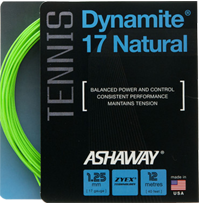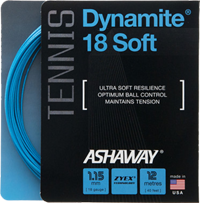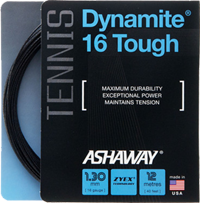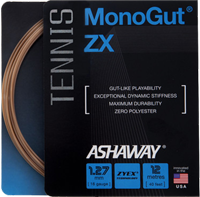|
|

Polyester, Polyketone and the Dynamics of Spin
By Steve Crandall
Vice President, Sales & Marketing
Ashaway Racket Strings
In tennis these days - much like politics - spin is all the rage. Everybody wants to improve their "up and down" game, and play like the top pros with "heavy balls" that drop like
stones just inside the base line. And to generate that spin many are also emulating the pros
by using the same "high tech" high-performance polyester strings, aka "gut on steroids."
But what they're finding, unfortunately, is that polyester strings don't work as well for them.
They feel like they have to work much harder with these strings to get less; and get worked
over pretty hard by them in return. One fellow likened playing with them to "hitting a brick
wall with a baseball bat."
So is polyester all it's cracked up to be when it comes to spin, and is it the right string for
you? The answer is yes, and no.
In our last column, we talked about how stiff polyester strings are and how - in addition to
rattling your teeth when you hit the ball with them - they actually generate less power than
other string materials like gut and the new polyketone materials like Zyex®. So then, how is it possible for a string that generates less power to also generate more spin?
Crawford Lindsey and company at Tennis Warehouse University have studied spin
extensively, and published a number of highly technical reports on the mechanics and
physics of spin on the TWU website. Their comparative study, Which Strings Generate the
Most Spin, concluded that polyester strings do indeed generate more spin: on average,
about 25% more than nylon and 7% more than natural gut. But they also point out that:
1. The player has by far the larger role in generating spin. Racquet head speed, angle of
racquet, and angle of swing basically trump all other considerations. Other non-equipment
factors include incoming ball speed, angle and amount of topspin.
2. While string material, tension and stringing pattern do play a role, the key factor in this
regard is lateral string movement and snap-back. Polyester simply moves laterally more
easily than nylon or gut, and thus produces more spin.
But, they ask in a follow-up report, String 'Snap-Back' and Spin, "What is it about the string / material that makes it move and stretch laterally? The candidates from TWU string properties testing would suggest stiffness, tension loss, and slipperiness as the main candidates. Polyester is stiffer, loses more tension, and is slippery. The stiffer material may be more able to overcome interstring friction or move faster, the lower tension decreases interstring friction enabling more movement, and slipperiness (low coefficient of friction - COF) also lessens interstring friction. These may all act in interactive combinations to facilitate string movement and snap-back."
So the key element here is interstring friction.
In another report, String Movement and Spin, they point out that, "because polyester string
is stiffer than other strings, it deforms the ball more, which loses energy, and this results in
less power for the same swing. Because the ball had less speed, players swung faster to get
more depth. But swinging faster (at an angle to the ball) causes more spin, so they could
swing faster again, and so on - more speed, more spin, more speed, more spin."
In short, high performance polyester strings work for the top pros because they are top
pros. They swing harder and faster, hit at better swing and racquet angles, and are more
likely to hit with the sweet spot on the racquet. Thus, they are able to do things with these
strings that the rest of us can't. But even the pros have their limits with polyesters. Many
are stringing at lower tensions or going to hybrid set-ups to reduce stiffness and impact
shock. And you'll notice that when they do occasionally off-hit, the ball goes zooming away
like a rocket. High performance polyesters are like formula-one racecars: they take a lot of
skill to drive.
So, what's a poor recreational player to do (or even a pro who's sick of getting beaten up by
his string)? Is there another way to generate spin?
Although Crawford Lindsey and company have yet to study it scientifically, reports we're
getting at Ashaway from players of all stripes indicate that polyketone-based strings like our
MonoGut® ZX do indeed generate spin like polyesters, and do so easier and more
comfortably with less impact shock on players' arms and shoulders. To understand how this
works, we need to go back to our discussion of Dynamic Stiffness (Ashaway's Zyex®-Based Tennis Strings: the New "Manmade Natural Gut"). Dynamic stiffness is a measure of a string's elasticity and ability to "snap back." The more a string stretches, the more power it returns to the ball. The less it stretches, the more energy is lost in flattening the ball and
the less total power is available for rebound.
This is true regardless of whether a string stretches perpendicular to the string bed as in a
straight hit, or lateral to the string bed in generating spin, so long as friction does not get in
the way. The reason nylon generates less spin than polyester is because nylon strings are
stickier than polyester. Their snap-back gets stuck. Gut is less sticky than nylon, but is still
stickier than polyester. Our evidence suggests that polyketone is as slippery as polyester,
especially when configured as a monofilament in MonoGut ZX. So you get more spin with
less work. We call it Dynamic Spin.
This gives you the best of both worlds. Rather than a highly specialized 'formula-one' string,
polyketone or Zyex strings are like Porsches. You get all the power and handling of a finely
built racing machine, but it drives easily and you can take it on the road.
The dynamic stiffness of Zyex is the closest to natural gut of any synthetic string material.
It absorbs and returns impact force more like gut. It controls the ball more like gut,
especially in thinner gauge strings, and holds tension as well, or perhaps even a bit better
than gut. Better, Zyex can be constructed as a multifilament (Ashaway Dynamite 17 Natural
or Dynamite 18 Soft); as a multistranded monofilament (Ashaway Dynamite 16 Tough); or,
as a straight monofilament in our new MonoGut ZX and MonoGut ZX Red. This, along with a
broader range of gauges than either polyesters or gut, allows you to more closely tailor your
string choice to your style of play. Take one for a spin and let us know how it works for you.
 |
 |
 |
 |
| Unlike polyesters and co-polymers, which are primarily monofilament constructions, Zyex can be constructed as a multifilament (Ashaway Dynamite 17 Natural or Dynamite 18 Soft); as a multistranded monofilament (Ashaway Dynamite® 16 Tough); or, as a straight monofilament in our new MonoGut ZX and MonoGut ZX Red. This, along with a broader range of gauges than either polyesters or gut, allows players to more closely tailor their string choice to their style of play. |
|

